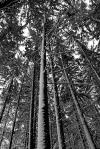We live in a world where I can, if I like, do just about anything to an image. I can make the noon-day light appear dramatic, I can replace a drab sky with a spectacular one, I can liven up the scene by adding a unicorn (or two!). And, what’s more, I can do all of that (and much, much more) and make it all look genuinely realistic. (For the moment we’ll leave aside the metaphysical question of how to make a scene including a unicorn (or two!) look “realistic.”)
Yes, I can do all that. But just because I can, doesn’t necessarily mean that I should. On the other hand, it doesn’t necessarily mean that I shouldn’t, either.
I have read and heard many opinions, over the past 20-odd years–corresponding with a period of time where vast, readily available means for substantial manipulation of digital imagery has become commonplace–about what the limits of digital manipulation ought to be, based on a seemingly equally vast set of criteria. For the purposes of this discussion, I’m going to limit consideration to images intended for something other than documentary, journalistic or evidentiary purposes. In this entry, I’m talking about “artsy” images only. And I’m also going to set aside any discussion about the parameters and obligations of being truthful about what one has in fact done in the way of manipulation. For instance, I’m not going to attempt to parse the distinctions between whether a person ought to be voluntarily forthcoming about what actions have been taken, or whether a person only need to cop to the truth if he/she is directly asked, or whether it’s okay to remain mum regardless. That discussion isn’t irrelevant, but it’s not what I want to focus on here. For the purposes of this post, let’s assume that the image in question is never going to reach the broader public, which makes the above considerations moot.
It might be helpful to have an actual example to work with, so here’s one:
The image in question was made in 2007. It is a focus-stacked image (seven frames) to overcome depth of field limitations, but other than a basic curves adjustment to enhance contrast a bit, a modest saturation mask application and (probably) cloning out some dust spots in the sky, nothing was done to the focus-stack composite. Most significantly, no actual objects were cloned in or out or moved. Nor was the sky changed or anything of that nature.
Now, one could argue that nothing of that nature need be done, thank you very much, that the image is just fine as it is. But here’s the thing: more than 16 years ago, when I posted this image on a (bleech) photo critique website, it received plenty of positive responses, including one by someone who said (I’m going to have to paraphrase; it has been 16 years) something along the lines of “I only wish the moon was further to the left in the arch frame, to better balance the butte in the lower right.”
Guess what? So do I! But the moon wasn’t further to the left. It was (relative to my position, the only one that allowed me to center the arch window and include the moon and butte in the frame) exactly where it appears in the image above.
But! I could move the moon couldn’t I? I mean…it’s even easier than inserting a unicorn (or two!) in the image.
Yes. Yes, I have no doubt that I could.
The honest truth is, I have never tried to relocate the moon in this image (or any other), even though I’m 100% certain that I could not only do so, but that I could do so utterly without visible artifacts in a matter of less than one minute of my time.
If this is such an easy process, why haven’t I performed this action? The reason, I believe, drives right to the heart of where the editing limits lie–in my opinion, of course–and why I’ve never replaced a sky with a “better one” in an image, or why I haven’t, for instance, inserted a unicorn (or two!), or anything else, in an image.
I don’t think that there’s anything inherently wrong with doing these things; the decision making locus, as I see it, revolves around the question of intent. And my overarching intent when editing an image is to have the end product bring me back to the moment when the image was captured. If I were to move the moon to the “ideal” spot in the frame in the Bisti Badlands image above, viewing the final product would ultimately remind me…that I’d moved the moon. That fact would overshadow any memory of the time and place that the image was created. It would, in the end, be counter to my intent.
Now, if my intent was for instance, to create the most pleasing piece of visual art that I could, moving the moon would not only be acceptable, it would be a mistake not to move it. But, as noted, that’s not what I’m trying to do.
In the end, I think we all know what the editing limits are for ourselves. Grand discussions of the subject are, I believe, largely superfluous. We know our own intent, and we know equally well what is consistent with that intent and what is not.
















































